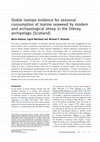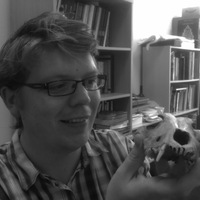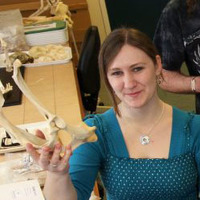Papers by Ingrid Mainland
Http Dx Doi Org 10 1080 00665983 2011 11020828, Dec 20, 2014
Island evolution may be expected to involve fast initial morphological divergence followed by sta... more Island evolution may be expected to involve fast initial morphological divergence followed by stasis. We tested this model using the dental phenotype of modern and ancient common voles (Microtus arvalis), introduced onto the Orkney archipelago (Scotland) * Deceased.
Science, 2009
The following resources related to this article are available online at
Science, 2009
The following resources related to this article are available online at
Environmental Archaeology, 2016
Journal of Archaeological Science: Reports, 2015

No Until recently, osteological studies into ancient diet and health have primarily focused upon ... more No Until recently, osteological studies into ancient diet and health have primarily focused upon human remains. As a result, these areas of research are still in their infancy in the field zoo-archaeology. Animals have paid a heavy price for many major human advances, such as those in agriculture and transport. This use (and often abuse) of animals has left many tell-tale signs in their teeth and bones. Along with the many advantages in animal exploitation have also come major problems for humans. Thus, infectious diseases passed from animals to humans must have long played a significant evolutionary role in the development of society. The zooarchaeological record could provide an extremely important temporal framework for exploring and understanding past and current issues of human health and animal welfare. This volume provides one of the first contributions to the field, and may stimulate many more.

Microwear analysis of pig teeth from the classical site of Sagalassos (SW Turkey) is undertaken t... more Microwear analysis of pig teeth from the classical site of Sagalassos (SW Turkey) is undertaken to obtain insight into pig management strategies in this region from the 1st to 7th centuries AD. Earlier research on modern pigs revealed significant differences in microwear patterns between stall-fed and free-ranging, rooting individuals. A comparison of the microwear data of the Sagalassos pig with those from archaeological and modern pigs with a known or presumed type of management shows that the microwear of the Sagalassos pigs is very different. It is suggested that the Sagalassos pigs had a very soft, non-abrasive diet, that in the first instance cannot be attributed to either management type. Therefore, the nature of the substrate on which the animals were foraging and its impact on microwear are considered and the microwear data are compared with the results of previous archaeozoological research carried out at the site. Further, diachronic changes in microwear patterns are investigated.
Environmental Archaeology, 1999
Environmental Archaeology, 1996
Environmental Archaeology, 1999
Environmental Archaeology, 1996
Environmental Archaeology, 1996
International Journal of Osteoarchaeology, 2000
The potential of dental microwear for recognizing the use of seaweed as fodder in the past is exp... more The potential of dental microwear for recognizing the use of seaweed as fodder in the past is explored through the analysis of microwear patterning in modern seaweed-eating and grazing sheep from Orkney. Seaweed-eating and grazing sheep are clearly distinguished on the ...

Environmental Archaeology, 2009
The use of seaweed as fodder for domestic animals during winter has been suggested for the North ... more The use of seaweed as fodder for domestic animals during winter has been suggested for the North Atlantic isles in prehistory with reference to a historically attested practice. We tested the use of stable isotope analysis in tooth enamel bioapatite to detect seasonal consumption of seaweed on modern sheep from the Orkney archipelago, with no contribution, seasonal contribution or exclusive contribution of seaweed to diet. There was no overlap between the d 13 C of local terrestrial vegetation and marine plants available on the shore. Sheep relying on seaweed had enamel d 13 C values as high as 23?1ø, differing from grazing sheep with enamel d 13 C values comprised between 217?7ø and 215?1ø. Seaweed consumption was also reflected in lower amplitudes of intra-tooth variation in enamel d 18 O values (0?3ø to 1?8ø in seaweed-eating sheep; 3?6ø to 4?1ø in grazing sheep), likely due to ingestion of oceanic water. The protocol was applied to archaeological assemblages from the same archipelago. A winter consumption of seaweed was detected in one sheep from the Neolithic site of Point of Cott and one sheep from the Iron Age assemblage of Mine Howe. No contribution of seaweed to the sheep diet was shown at the Late Norse site of Earl's Bu.
Journal of Archaeological Science, 2011
The Early Bronze Age barrows at Irthlingborough and Gayhurst in central England are notable for t... more The Early Bronze Age barrows at Irthlingborough and Gayhurst in central England are notable for the large number of cattle (Bos taurus) remains associated with their human Beaker burials. Previous work using strontium isotope analysis has indicated that most of the cattle analysed, and one aurochs (Bos primigenius), were of local origin [Towers, J., Montgomery, J., Evans, J., Jay, M.,










Uploads
Papers by Ingrid Mainland
range from neutral to slightly acidic or slightly alkaline. These finds of mammal, birds, fish and (occasionally)
amphibian or reptile bone may reflect the disposal of waste materials associated with the use of animal
products for food, for artefact production or other uses such as hides, fur or wool.1 Equally, archaeological
bone can derive from the more intentional and purposeful deposition of animal bodies or animal body
parts (referred to as Animal Bone Groups or ABGs), often reflecting symbolic or non-functional attitudes to
animals. Common examples include the caching and display of feasting debris,2 and the incorporation of
animal bodies into foundation or closing deposits.3 Animal skeletal material may also become accidentally
incorporated into archaeological deposits through the actions of predator species such as owls or dogs.4 The
faunal assemblage from the Ness of Brodgar, which with an estimated size of c.175,000 fragments is one of
the largest bone collections in Neolithic Scotland, accumulated through all these processes.